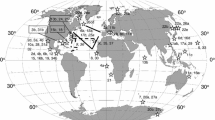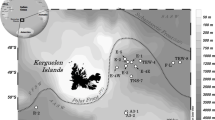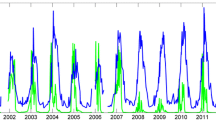Abstract
Respiration (=oxygen consumption) rates of 28 zooplankton species belonging to 10 taxa from 500 to 5,000 m depth of the western subarctic Pacific Ocean were determined as 0.027–0.44 μLO2 mg dry mass−1 h−1 at in situ temperatures (1.5–3 °C), which are 80 % lower than the rates of the epipelagic Antarctic zooplankton with similar body mass and at a comparable temperature. In terms of adjusted metabolic rate to 1 mg body N (AMR; μLO2 mg N−0.8 h−1) at 1 °C, the present results (mean 1.66) fall well within the range (0.84–3.32) reported for copepods, chaetognaths, and mixed crustaceans from 500 to 7,000 m in the subarctic Pacific Ocean and Antarctic waters. Judging from their body C:N elemental ratios and ash-free dry mass (=organic matter) data, the major component of organic matter is deduced to be protein (C:N = 3.4–8.1, by mass) for 19 out of 28 species and lipids (C:N = 8.6–13.0) for the remaining 9 species.


Similar content being viewed by others
References
Bailey TG, Youngbluth MJ, Owen GP (1995) Chemical composition and metabolic rates of gelatinous zooplankton from midwater and benthic boundary layer environments off Cape Hatteras, North Carolina, USA. Mar Ecol Prog Ser 122: 121–134
Båmstedt U (1986) Chemical composition and energy content. In: Corner EDS, O’Hara SCM (eds) The biological chemistry of marine copepods. Clarendon, Oxford, pp 1–58
Chihara M, Murano, M (1997) An illustrated guide to marine plankton in Japan. Tokai University Press, Tokai (in Japanese)
Childress JJ (1975) The respiratory rates of midwater crustaceans as a function of depth of occurrence and relation to the oxygen minimum layer off southern California. Comp Biochem Physiol 50A: 787–799
Childress JJ (1995) Are there physiological and biochemical adaptations of metabolism in deep-sea animals? Trends Ecol Evol 10: 30–36
Childress JJ, Nygaard M (1973) The chemical composition of midwater fishes as a function of depth of occurrence off southern California. Deep-Sea Res 20: 1093–1109
Childress JJ, Nygaard M (1974) Chemical composition and buoyancy of midwater crustaceans as a function of depth of occurrence off Southern California. Mar Biol 27: 225–238
Childress JJ, Thuesen EV (1993) Effects of hydrostatic pressure on metabolic rates of six species of deep-sea gelatinous zooplankton. Limnol Oceanogr 38: 665–670
Favorite F, Dodimead AJ, Nasu K (1976) Oceanography of the subarctic Pacific region, 1960–1971. Bull Int Pacif Fish Commn 33: 1–187
Hernández-León S, Ikeda T (2005) Zooplankton respiration. In: del Giorgio PA, leb Williams PJ (eds) Respiration in aquatic ecosystems. Oxford University Press, Oxford, pp 57–82
Ikeda T (1974) Nutritional ecology of marine zooplankton. Mem Fac Fish Hokkaido Univ 22: 1–97
Ikeda T (1985) Metabolic rates of epipelagic marine zooplankton as a function of body mass and temperature. Mar Biol 85: 1–44
Ikeda T (1988) Metabolism and chemical composition of crustaceans from the Antarctic mesopelagic zone. Deep-Sea Res 35: 1991–2002
Ikeda T (2011) Metabolic activity of pelagic copepods from 5,000 to 7,000 m depth of he western subarctic Pacific, as inferred from electron transfer system (ETS) activity. J Oceanogr 67: 785–790
Ikeda T, Mitchell A (1982) Oxygen uptake, ammonia excretion and phosphate excretion by krill and other Antarctic zooplankton in relation to their body size and chemical composition. Mar Biol 71: 283–298
Ikeda T, Takahashi T (2012) Synthesis towards a global-bathymetric model of metabolism and chemical composition of marine pelagic chaetognaths. J Exp Mar Biol Ecol 424–425: 78–88
Ikeda T, Torres JJ, Hernandez-Leon S, Geiger SP (2000) Metabolism. In: Harris RP, Wiebe PH, Lenz J, Skjoldal HR, Huntley M (eds) ICES zooplankton methodology manual. Academic, San Diego, pp 455–532
Ikeda T, Sano F, Yamaguchi A, Matsuishi T (2006a) Metabolism of mesopelagic and bathypelagic copepods in the western North Pacific Ocean. Mar Ecol Prog Ser 322: 199–211
Ikeda T, Yamaguchi A, Matsuishi, T (2006b) Chemical composition and energy content of deep-sea calanoid copepods in the Western North Pacific Ocean. Deep-Sea Res I 53: 1791–1809
Ikeda T, Sano F, Yamaguchi A (2007) Respiration in marine pelagic copepods: a global-bathymetric model. Mar Ecol Prog Ser 339: 215–219
Ivleva, IV (1980) The dependence of crustacean respiration rate on body mass and habitat temperature. Int Rev Ges Hydrobiol 65: 1–47
Kawamura A (1968) Performance of Peterson type closing net. Bull Plankton Soc Jpn 15: 11–12
Kruse S, Brey T, Bathmann U (2010a) Role of midwater chaetognaths in Southern Ocean pelagic energy flow. Mar Ecol Prog Ser 416: 105–113
Kruse S, Hagen W, Bathmann U (2010b) Feeding ecology and energetics of the Antarctic chaetognaths Eukrohnia hamata, E. bathypelagica and E. bathyantarctica. Mar Biol 157: 2289–2302
Lee RF, Hagen W, Kattner G (2006) Lipid storage in marine zooplankton. Mar Ecol Prog Ser 307: 273–306
Menard HW, Smith SM (1966) Hypsometry of ocean basin provinces. J Geophys Res 71: 4305–4325
Omori M (1969) Weight and chemical composition of some important oceanic zooplankton in the North Pacific Ocean. Mar Biol 3: 4–10
Seibel BA, Drazen JC (2007) The rate of metabolism in marine animals: environmental constraints, ecological demands and energetic opportunities. Phil Trans R Soc Lond B 362: 2061–2078
Sokal RR, Rohlf FJ (1995) Biometry. The principles and practice of statistics in biological research. Freeman, New York
Thuesen EV, Childress JJ (1993) Enzymatic activities and metabolic rates of pelagic chaetognaths: Lack of depth-related declines. Limnol Oceanogr 38: 935–948
Thuesen EV, Miller CB, Childress JJ (1998) Ecophysiological interpretation of oxygen consumption rates and enzymatic activities of deep-sea copepod. Mar Ecol Prog Ser 168: 95–107
Ventura M (2006) Linking biochemical and elemental composition in freshwater and marine crustacean zooplankton. Mar Ecol Prog Ser 327: 233–246
Acknowledgments
I am grateful to two anonymous referees for their comments which improved the text. I thank A.D. McKinnon for reviewing earlier drafts of this paper, and H. Kaeriyama for the identification of ostracods. Thanks are due to the Captain, officers and crew members of the “T.S. Oshoro-Maru” for their help in field sampling, and H. Matsumoto and A. Maeda of the Center for Instrumental Analysis of Hokkaido University for CHN elemental analysis. Part of this study was supported by grant JSPS KAKENSHI 14209001.
Author information
Authors and Affiliations
Corresponding author
Rights and permissions
About this article
Cite this article
Ikeda, T. Metabolism and chemical composition of zooplankton from 500 to 5,000 m depth of the western subarctic Pacific Ocean. J Oceanogr 68, 641–649 (2012). https://doi.org/10.1007/s10872-012-0124-x
Received:
Revised:
Accepted:
Published:
Issue Date:
DOI: https://doi.org/10.1007/s10872-012-0124-x




